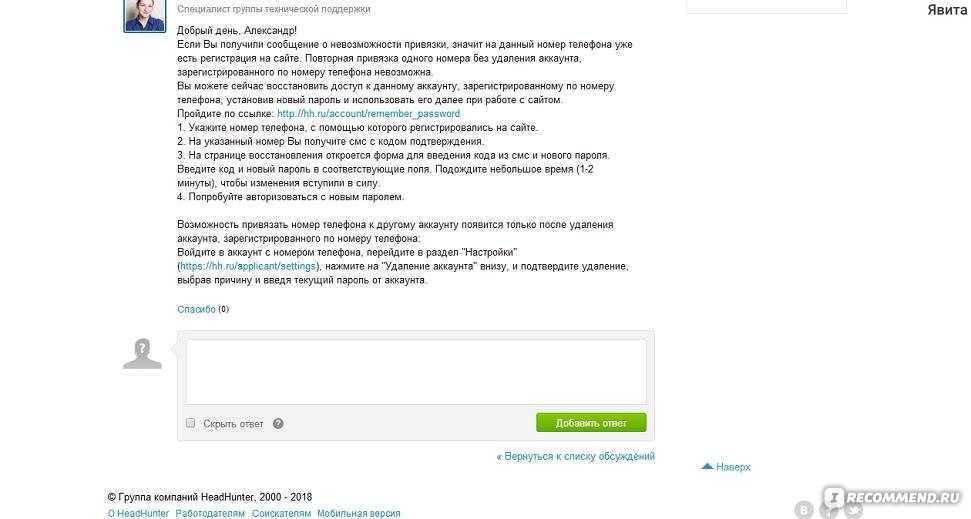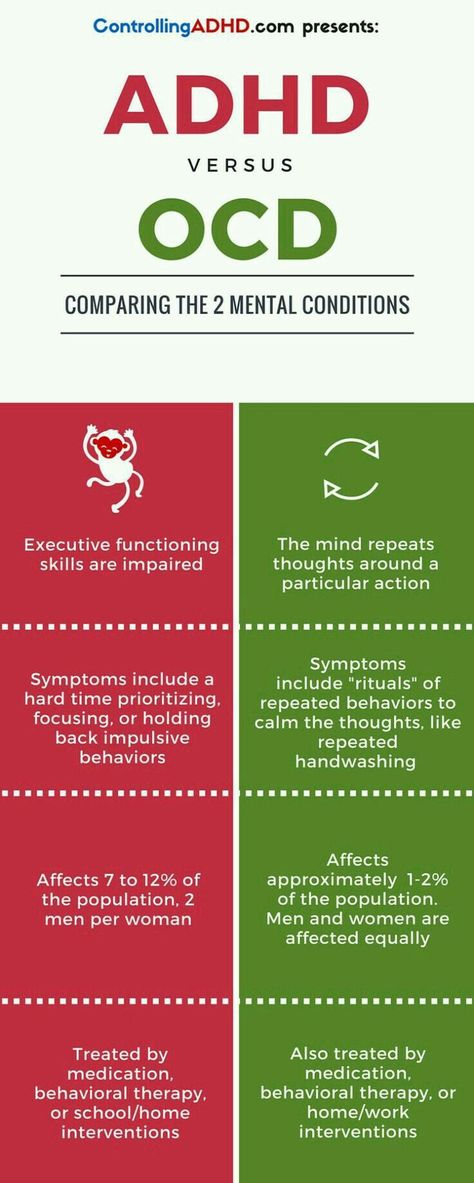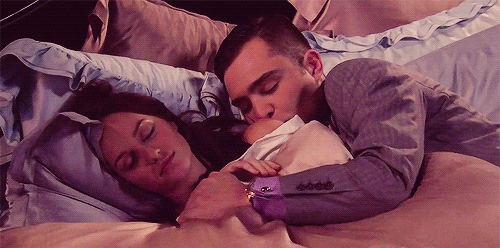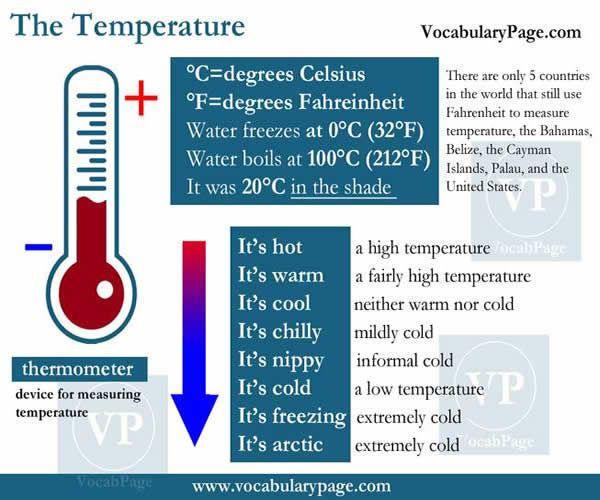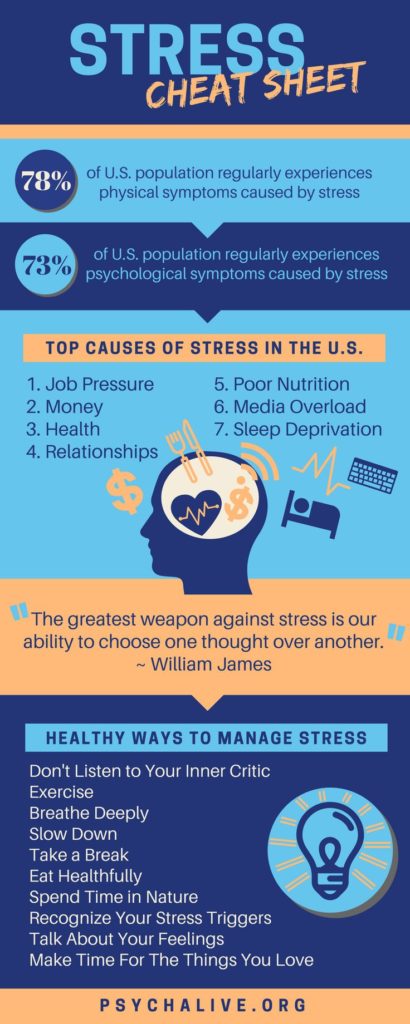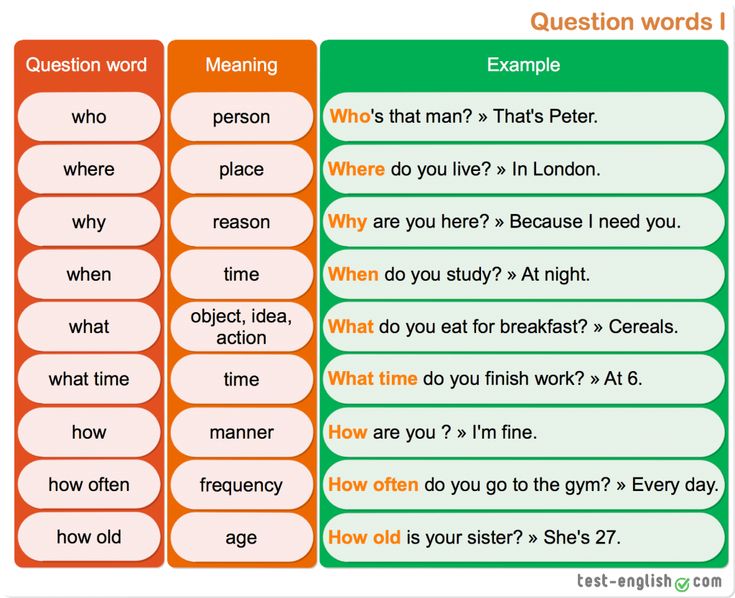Dsm v codes bipolar
DSM-5 Bipolar Disorder Diagnostic Codes
Find a clear chart with the updated and consolidated codes for bipolar disorder below.
Since the DSM-5 was published in 2013, updates have been made to the codes for bipolar I and bipolar II disorders. After a long period of revisions and adaptation, the ICD-10 coding system replaced the ICD-9 code set on October 1, 2015.
The main goals of changing to the ICD-10 system were to:
- increase the specificity of diagnoses
- keep up to date with changes in clinical practices and medical technology
- improve tracking of conditions
The change to ICD-10 has had a relatively small impact on the rates of bipolar diagnoses, unlike those of some other medical conditions.
For your convenience, we’ve displayed the new ICD-10-CM codes for bipolar disorder here, with the old DSM-IV codes listed below.
Bipolar I disorder
| Current episode: | Hypomanic | Manic | Depressive | Mixed |
| Unspecified | F31. | F31.10 | F31.30 | F31.60 |
| Mild | N/A | F31.11 | F31.31 | F31.61 |
| Moderate | N/A | F31.12 | F31.32 | F31.62 |
| Severe | N/A | F31.13 | F31.4 | F31.63 |
| With psychotic features | N/A | F31.2 | F31.5 | F31.64 |
| In partial remission | F31.71 | F31.73 | F31.75 | F31.77 |
| In full remission | F31.72 | F31.74 | F31.76 | F31.78 |
Related codes
- F31.8 Other bipolar disorders
- F31.81 Bipolar II disorder
- F31.89 Other bipolar disorder
- F31.9 Bipolar disorder, unspecified
- F34.0 Cyclothymic disorder
Note: Bipolar II disorder has one diagnostic code, F31.81
Bipolar II disorder, defined by a minimum of one hypomanic episode and one major depressive episode, has only one diagnostic code.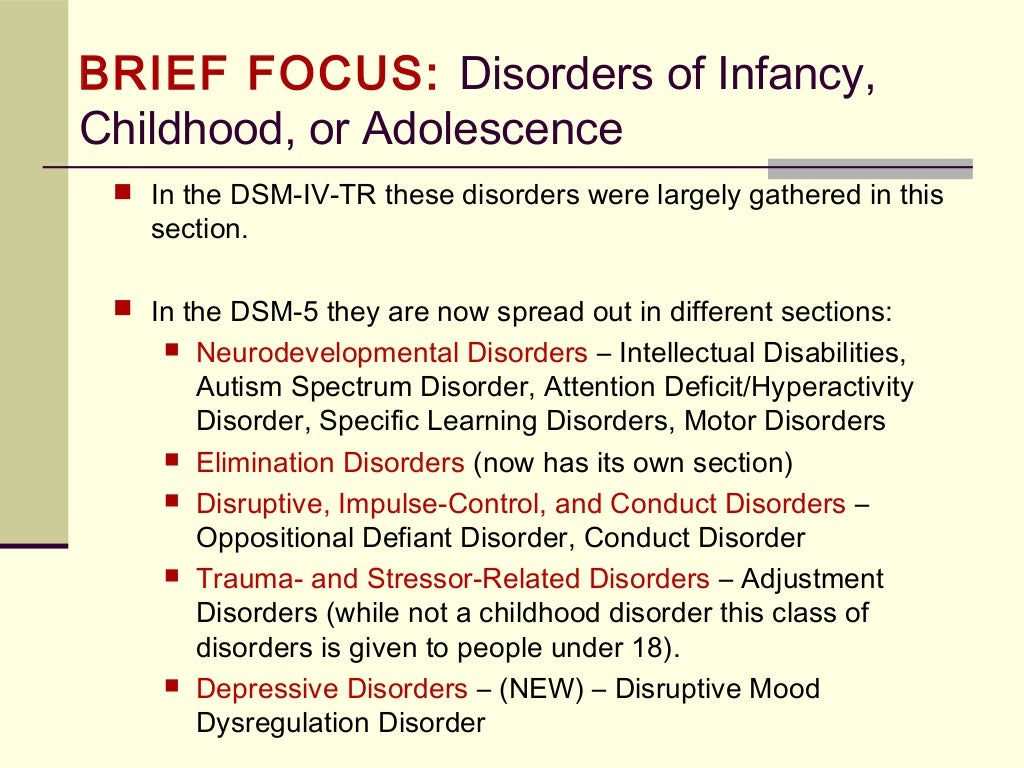
Further details including current severity, presence of psychotic features, course, and other specifiers can’t be coded but should be recorded wherever the diagnosis is documented.
For example: F31.81 bipolar II disorder, current episode manic, mild severity, with mixed features.
Now consolidated: Bipolar — Single Manic
- 296 Bipolar I disorder, single manic episode, unspecified
- 296.01 Bipolar I disorder, single manic episode, mild
- 296.02 Bipolar I disorder, single manic episode, moderate
- 296.03 Bipolar I disorder, single manic episode, severe without psychotic features
- 296.04 Bipolar I disorder, single manic episode, severe with psychotic features
- 296.05 Bipolar I disorder, single manic episode, in partial remission
- 296.06 Bipolar I disorder, single manic episode, in full remission
Now consolidated: Bipolar — Manic
- 296.4 Bipolar I disorder, most recent episode hypomanic
- 296.
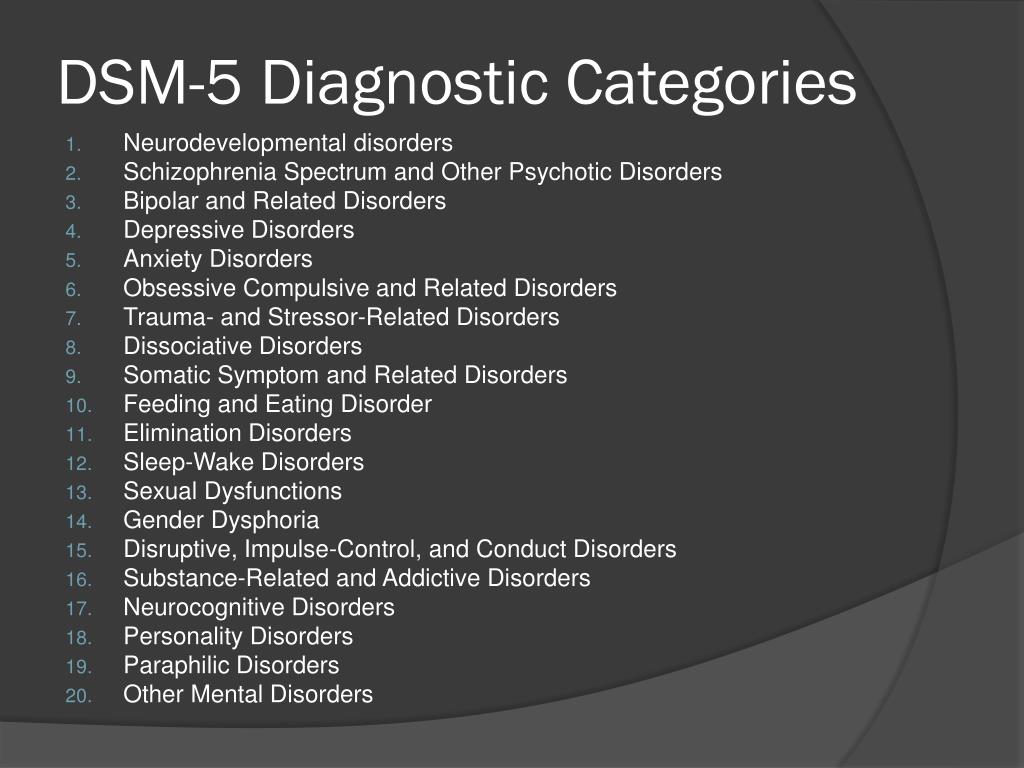 4 Bipolar I disorder, most recent episode manic, unspecified
4 Bipolar I disorder, most recent episode manic, unspecified - 296.41 Bipolar I disorder, most recent episode manic, mild
- 296.42 Bipolar I disorder, most recent episode manic, moderate
- 296.43 Bipolar I disorder, most recent episode manic, severe without psychotic features
- 296.44 Bipolar I disorder, most recent episode manic, severe with psychotic features
- 296.45 Bipolar I disorder, most recent episode manic, in partial remission
- 296.46 Bipolar I disorder, most recent episode manic, in full remission
Now consolidated: Bipolar — Depressed
- 296.5 Bipolar I disorder, most recent episode depressed, unspecified
- 296.51 Bipolar I disorder, most recent episode depressed, mild
- 296.52 Bipolar I disorder, most recent episode depressed, moderate
- 296.53 Bipolar I disorder, most recent episode depressed, severe without psychotic features
- 296.54 Bipolar I disorder, most recent episode depressed, severe with psychotic features
- 296.
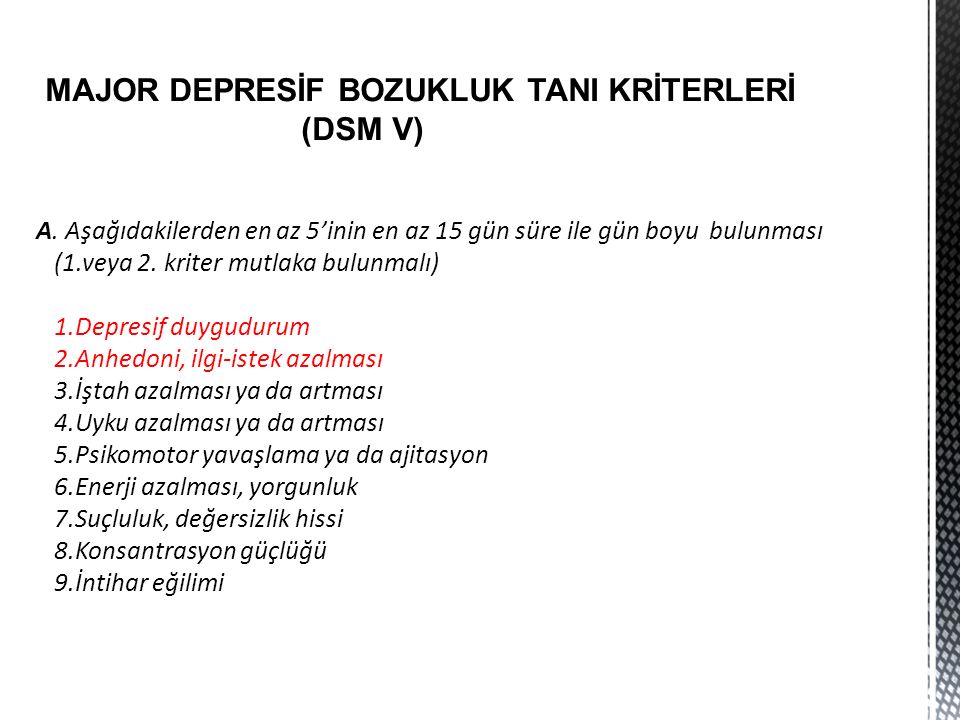 55 Bipolar I disorder, most recent episode depressed, in partial remission
55 Bipolar I disorder, most recent episode depressed, in partial remission - 296.56 Bipolar I disorder, most recent episode depressed, in full remission
Now consolidated: Bipolar — Mixed
- 296.6 Bipolar I disorder, most recent episode mixed, unspecified
- 296.61 Bipolar I disorder, most recent episode mixed, mild
- 296.62 Bipolar I disorder, most recent episode mixed, moderate
- 296.63 Bipolar I disorder, most recent episode mixed, severe without psychotic features
- 296.64 Bipolar I disorder, most recent episode mixed, severe with psychotic features
- 296.65 Bipolar I disorder, most recent episode mixed, in partial remission
- 296.66 Bipolar I disorder, most recent episode mixed, in full remission
- 296.7 Bipolar I disorder, most recent episode unspecified
- 296.8 Bipolar disorder NOS
- 296.89 Bipolar II disorder
- 296.9 Mood disorder NOS
| t8_1_1_1_1" rowspan="1" colspan="1">Disorder Class | Mood Disorders | Disorder Class | Bipolar and Related Disorders |
| Bipolar Disorder | DSM-IV specified 6 “types” of bipolar I disorder:
| Bipolar I Disorder | A.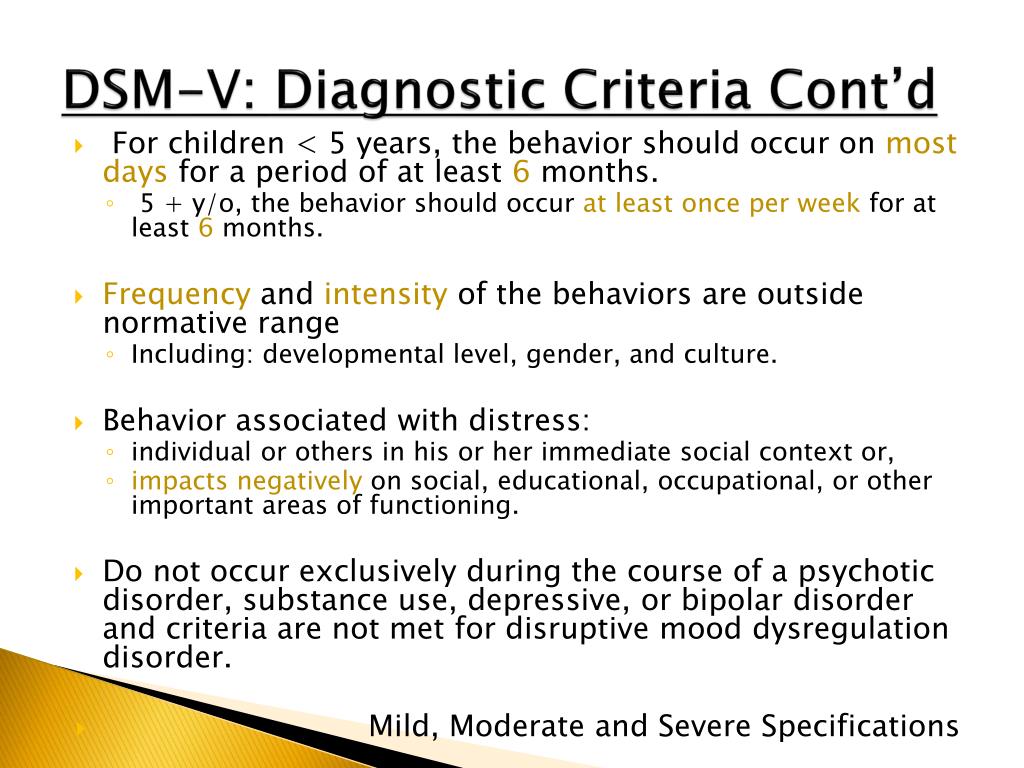 Criteria have been met for at least one manic episode (). The manic episode may have been preceded by and may be followed by hypomanic or major depressive episodes (see ). Criteria have been met for at least one manic episode (). The manic episode may have been preceded by and may be followed by hypomanic or major depressive episodes (see ).B. The occurrence of the manic and major depressive episode(s) is not better explained by schizoaffective disorder, schizophreniform disorder, delusional disorder, or other specified or unspecified schizophrenia spectrum and other psychotic disorder. Note: Major depressive episodes are common in bipolar I disorder but are not required for the diagnosis of bipolar I disorder. Note: Hypomanic episodes are common in bipolar I disorder but are not required for the diagnosis of bipolar I disorder. Specify:
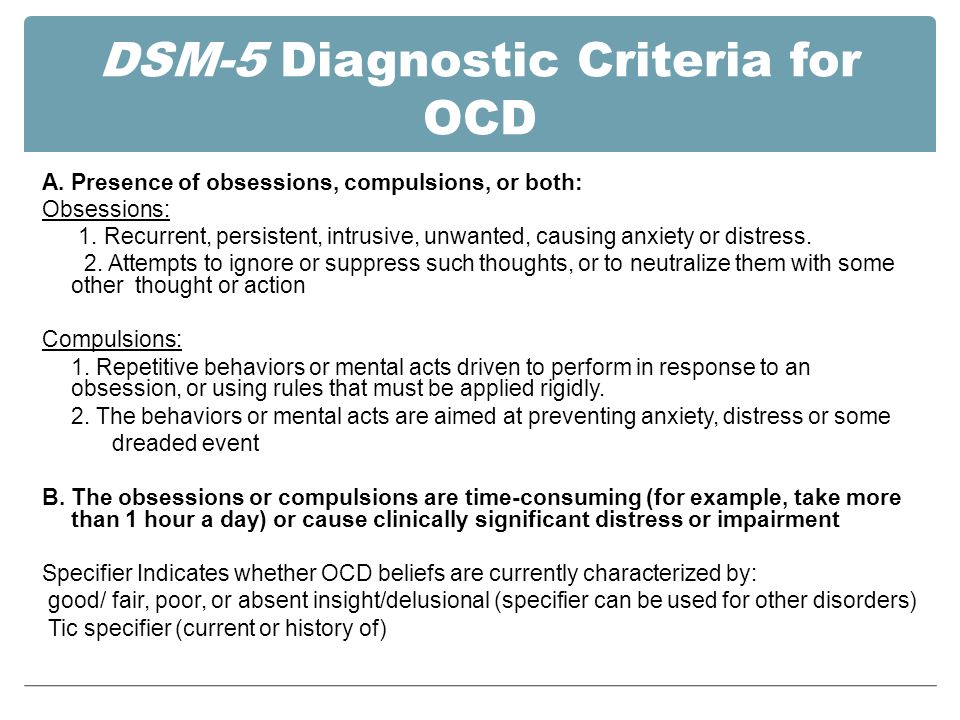 |
| Bipolar I Disorder, Single Manic Episode | A. Presence of only one manic episode (see ) and no past major depressive episodes (see ). Note: Recurrence is defined as either a change in polarity from depression or an interval of at least 2 months without manic symptoms. B. The manic episode is not better accounted for by schizoaffective disorder and is not superimposed on schizophrenia, schizophreniform disorder, delusional disorder, or psychotic disorder not otherwise specified. Specify if: Specify (for current or most recent episode):
| Bipolar I episode “types” dropped from criteria tables, but diagnostic procedure still includes noting most recent episode type.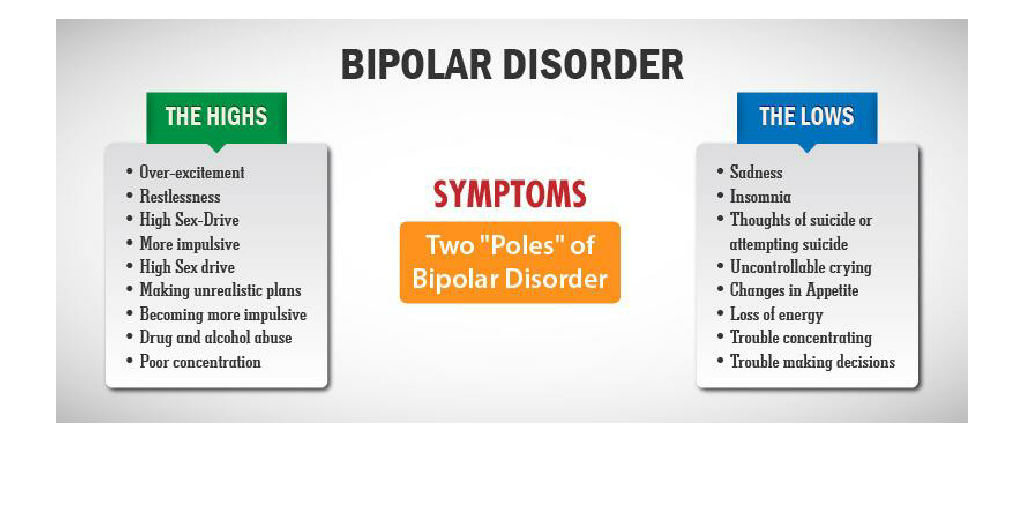 | |
| Bipolar I Disorder, Most Recent Episode Hypomanic | A. Currently (or most recently) in a hypomanic episode. B. There has previously been at least one manic episode or mixed episode. C. The mood symptoms cause clinically significant distress or impairment in social, occupational, or other important areas of functioning. D. The mood episodes in Criteria A and B are not better accounted for by schizoaffective disorder and are not superimposed on schizophrenia, schizophreniform disorder, delusional disorder, or psychotic disorder not otherwise specified. Specify:
| Bipolar I episode “types” dropped from criteria tables, but diagnostic procedure still includes noting most recent episode type. | |
| Bipolar I Disorder, Most Recent Episode Manic | A. Currently (or most recently) in a manic episode. B. There has previously been at least one major depressive episode, manic episode, or mixed episode. C. The mood episodes in Criteria A and B are not better accounted for by schizoaffective disorder and are not superimposed on schizophrenia, schizophreniform disorder, delusional disorder, or psychotic disorder not otherwise specified. Specify (for current or most recent episode):
| Bipolar I episode “types” dropped from criteria tables, but diagnostic procedure still includes noting most recent episode type. | |
| Bipolar I Disorder, Most Recent Episode Mixed | A. Currently (or most recently) in a mixed episode. B. There has previously been at least one major depressive episode, manic episode, or mixed episode. C. The mood episodes in Criteria A and B are not better accounted for by schizoaffective disorder and are not superimposed on schizophrenia, schizophreniform disorder, delusional disorder, or psychotic disorder not otherwise specified. Specify (for current or most recent episode):
| Bipolar I episode “types” dropped from criteria tables, but diagnostic procedure still includes noting most recent episode type. | |
| Bipolar I Disorder, Most Recent Episode Depressed | A. Currently (or most recently) in a major depressive episode. B. There has previously been at least one manic episode or mixed episode. C. The mood episodes in Criteria A and B are not better accounted for by schizoaffective disorder and are not superimposed on schizophrenia, schizophreniform disorder, delusional disorder, or psychotic disorder not otherwise specified. Specify (for current or most recent episode):
| Bipolar I episode “types” dropped from criteria tables, but diagnostic procedure still includes noting most recent episode type. | |
| Bipolar I Disorder, Most Recent Episode Unspecified | A. Criteria, except for duration, are currently (or most recently) met for a manic, a hypomanic, a mixed, or a major depressive episode. B. There has previously been at least one manic episode or mixed episode. C. The mood symptoms cause clinically significant distress or impairment in social, occupational, or other important areas of functioning. D. The mood symptoms in Criteria A and B are not better accounted for by schizoaffective disorder and are not superimposed on schizophrenia, schizophreniform disorder, delusional disorder, or psychotic disorder not otherwise specified | ||
| E. The mood symptoms in Criteria A and B are not due to the direct physiological effects of a substance (e.g., a drug of abuse, a medication, or other treatment) or a general medical condition (e.g., hyperthyroidism). Specify:
| Dropped |
🎖▷ Why You Don't Have to Worry About Weight Gain With Lamictal
Psychology
4,872 2 minutes read
If you're worried that taking Lamictal (lamotrigine) might cause weight gain, there's good news.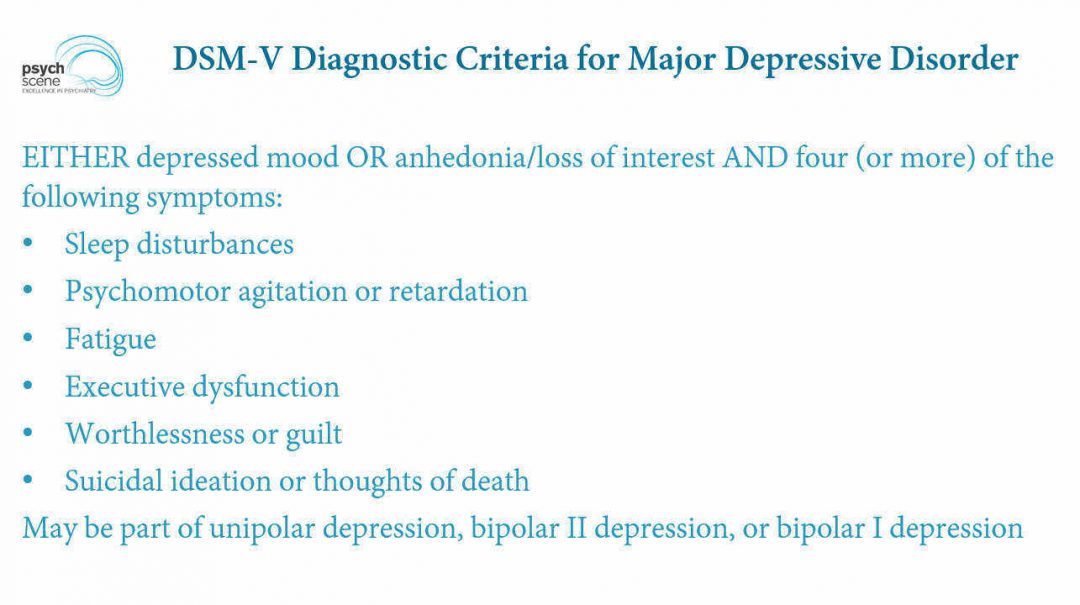 It probably won't affect your weight much. If anything, you're more likely to lose weight due to Lamictal than gain weight, but either way, the changes are likely to be pretty small.
It probably won't affect your weight much. If anything, you're more likely to lose weight due to Lamictal than gain weight, but either way, the changes are likely to be pretty small.
The effect of Lamictal on weight has been little studied and various clinical trials have found minimal effect. In fact, some researchers even considered the drug as a possible remedy for obesity and as a remedy for overeating. This information should be reassuring for people with bipolar disorder, as many of the medications used to treat this condition can cause weight gain.
Lamictal findings and weight gain or loss
Lamictal is an anticonvulsant that can be used to treat seizures such as epilepsy. It is also used as a mood stabilizer for bipolar disorder.
In the first clinical trials with the drug, 5 percent of adults with epilepsy lost weight while taking Lamictal, while 1 to 5 percent of patients with bipolar I disorder gained weight while taking the drug. The researchers do not disclose how much weight patients have gained or lost.
Meanwhile, a 2006 study comparing the effects on weight of Lamictal, lithium, and placebo found that some Lamictal-treated patients gained weight, some lost weight, and most remained about the same weight. Weight changes are usually not many pounds anyway. Obese patients taking Lamictal lost an average of four pounds, while the weight of non-obese patients remained virtually unchanged.
Relationship between weight gain and other bipolar drugs
Weight gain from medications used to treat bipolar disorder is unfortunately quite common. Some mood stabilizers commonly used for bipolar disorder, especially lithium and Depakote (valproate), carry a high risk of weight gain.
In addition, the atypical antipsychotics Clozaril (clozapine) and Zyprexa (olanzapine) tend to cause significant weight gain in people who take them. Finally, some antidepressants, notably Paxil (paroxetine) and Remeron (mirtazapine), have been associated with weight gain.
Therefore, if you are already overweight, you and your psychiatrist may want to consider additional weight gain when determining your bipolar medication regimen. Based on this, Lamictal may be a good choice.
Based on this, Lamictal may be a good choice.
Lamictal as a possible treatment for obesity
Lamictal has also been studied as a possible treatment for obesity in people without epilepsy or bipolar disorder.
In a small clinical study of 40 people conducted in 2006, researchers randomly assigned participants to receive either lamiktal or placebo for up to 26 weeks. Each participant in the study had a body mass index (BMI) between 30 and 40, placing them in the obese group to the level of severe obesity. Those who took Lamictal lost an average of just over 10 pounds. Those who took the placebo lost about 7 pounds in the meantime, so while those who took Lamictal lost more weight, they didn't lose all that much more.
Another study in 2009 looked at Lamictal as a remedy for overeating. This study involved 51 people with the condition that 26 of them received Lamictal, and 25 - placebo.
Those who took Lamictal lost more weight than those who took placebo (about 2. 5 pounds vs. about one third of a pound) and did have significant improvements in blood sugar and cholesterol lab test results. However, Lamictal did not appear to affect other aspects of the eating disorder when compared to placebo. 4 -th edition, text Revision reduced to DSM-IV-TR). It includes all currently recognized mental health disorders. The coding system used in the DSM is different from the International Classification of Diseases (ICD).
5 pounds vs. about one third of a pound) and did have significant improvements in blood sugar and cholesterol lab test results. However, Lamictal did not appear to affect other aspects of the eating disorder when compared to placebo. 4 -th edition, text Revision reduced to DSM-IV-TR). It includes all currently recognized mental health disorders. The coding system used in the DSM is different from the International Classification of Diseases (ICD).
Summary
- 1 Conditions usually diagnosed in infancy, late childhood or adolescence
- 1.1 Mental retardation
- 1.2 Learning Disabilities
- 1.3 Motor skills impairment
- 1.4 Communication disorders
- 1.5 General developmental disorders
- 1.6 Disruptive behavior and attention deficit
- 1.7 Eating disorder in infancy or infancy
- 1.
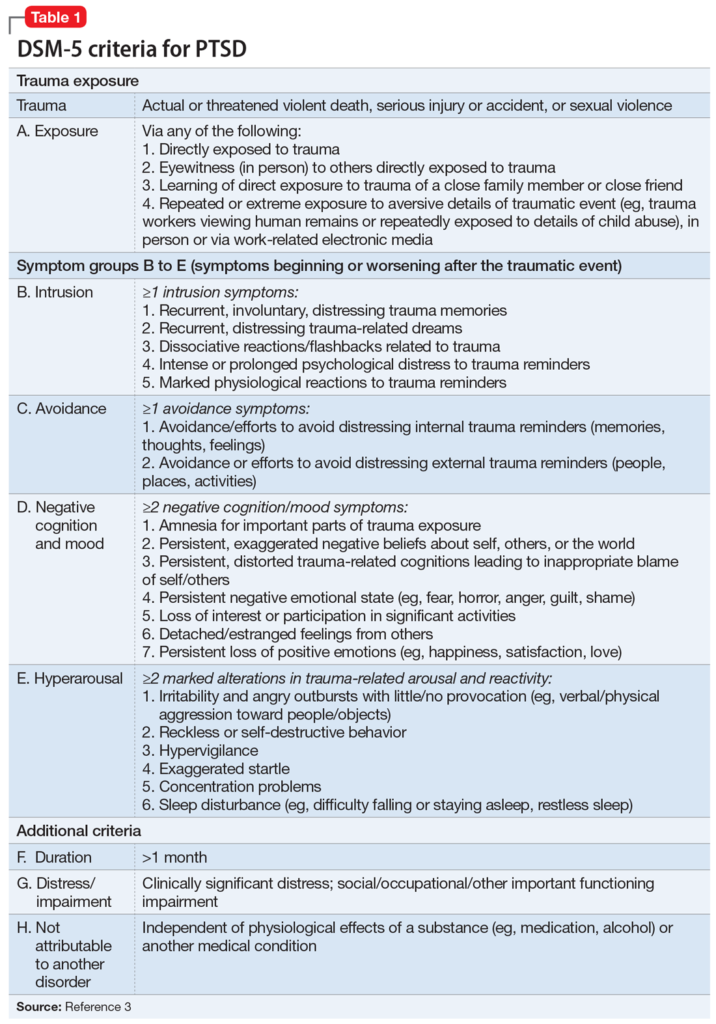 8 Vocalization/abnormal movements
8 Vocalization/abnormal movements - 1.9 Impaired sphincter control
- 1.10 Other disorders of infancy, infancy or adolescence
- 2 Delirium, dementia, amnestic disorder and other cognitive disorders
- 2.1 Brad
- 2.2 Dementia
- 2.3 Amnestic disorder
- 2.4 Other cognitive impairments
- 3 Mental disorders due to unspecified general disease
- 4 Substance use disorders
- 4.1 Alcohol related disorders
- 4.2 Amphetamine use disorders
- 4.3 Caffeine related disorders
- 4.4 Cannabis-related disorders
- 4.5 Cocaine related disorders
- 4.6 Hallucinogen-related disorders
- 4.7 Violations involving volatile solvents
- 4.8 Nicotine related disorders
- 4.9 Opioid related disorders
- 4.10 Phencyclidine related disorders
- 5 Schizophrenia and other psychotic disorders
- 6 Mood disorders
- 6.
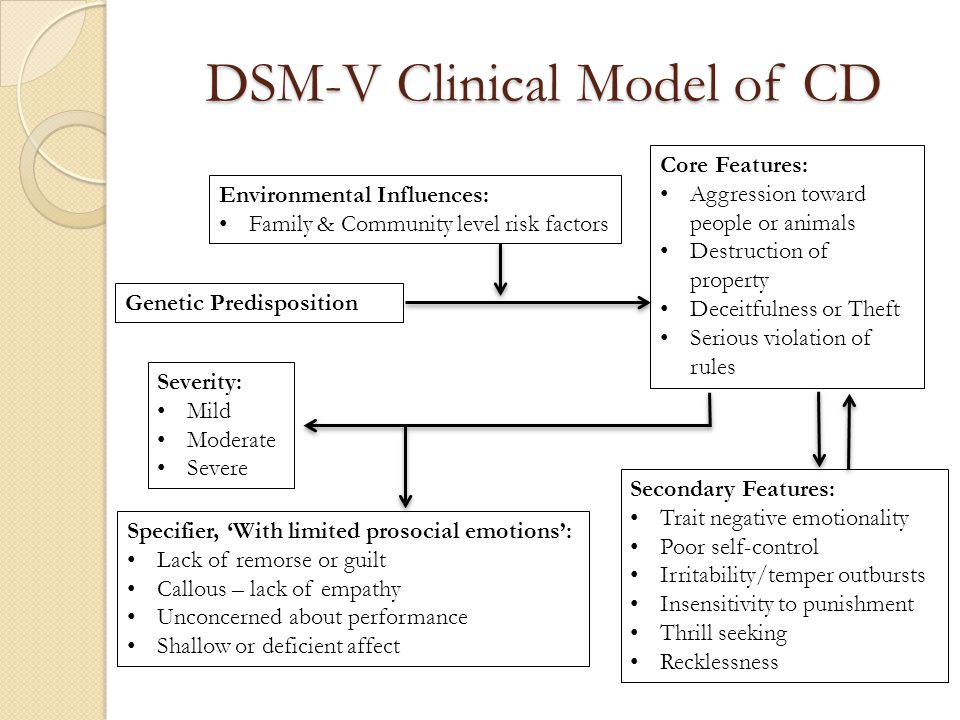 1 Depressive disorders
1 Depressive disorders - 6.2 Bipolar disorders
- 6.
- 7 anxiety disorders
- 8 Somatoform disorders
- 9 Patomimy
- 10 dissociative disorders
- 11 Sexual dysfunctions and gender identity disorders
- 11.1 Sexual dysfunctions
- 11.2 Deviations from sexual arousal
- 11.3 Gender identity disorder
- 12 Eating disorders
- 13 Sleep disorders
- 13.1 Primary sleep disorders
- 13.2 Parasomnias
- 13.3 Other sleep disorders
- 14 Impulse control disorder not specified
- 15 Adjustment Disorders
- 16 inappropriate personality traits
- 16.1 Related Articles
- 17 Notes and references
- 18 External links
Diseases usually diagnosed in infancy, late childhood, or adolescence.
Mental retardation
- 317 Mild mental retardation
- 318.
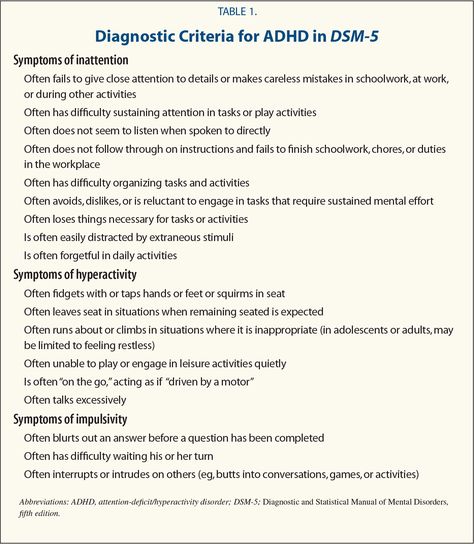 0 Moderate mental retardation
0 Moderate mental retardation - 318.1 Severe mental retardation
- 318.2 Profound mental retardation
- 319 Mental retardation, severity not specified
Learning disabilities
- 315.00 Reading disability
- 315.1 Settlement disorder
- 315.2 Written expression disorder
- 315.9 Not selected for learning
Motility disorder
- 315.4 Impaired coordination
Communication disorders
- 315.31 Expressive speech disorder
- 315.32 Mixed receptive/expressive speech disorder (dysphasia, receptive aphasia)
- 315.39 Phonological disorder
- 307.0 Stuttering
- 307.9 Communication disorder, unspecified
General Developmental Disorders
- 299.00 Autistic disorder
- 299.80 Rett's disease
- 299.10 Child disintegration disorder
- 299.80 Asperger's disease
- 299.
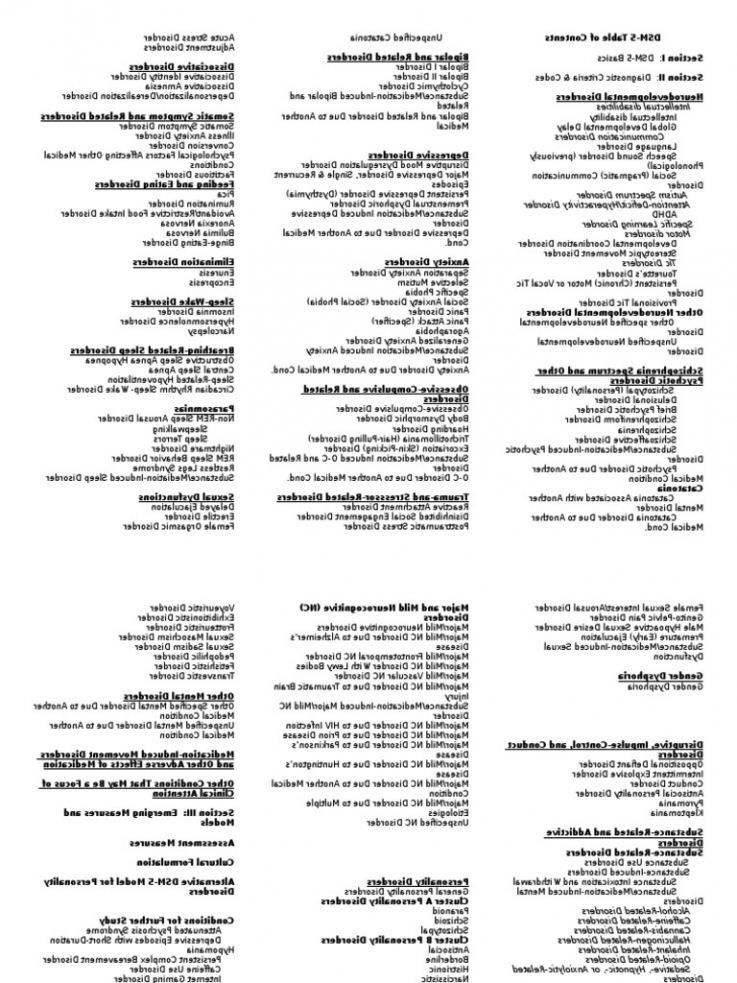 80 Common developmental disorder, unspecified.
80 Common developmental disorder, unspecified.
Disruptive behavior and attention deficit
- Attention Deficit Hyperactivity Disorder
- 314.01 Mixed type
- 314.01 Predominantly hyperactive-impulsive type
- 314.00 Predominantly inattentive type
- 314.9 Attention deficit/hyperactivity disorder not specified.
- Conduct disorders
- 312.81 Early childhood
- 312.82 Early adolescence
- 312.89 Start not specified
- 313.81 Oppositional defiant disorder
- 312.9Destructive behavior and attention deficit, unspecified
Eating disorder in infancy or infancy
- 307.52 Pica
- 307.53 Rumination
- 307.59 Eating disorder in infancy or infancy
Vocalization/abnormal movements
- 307.23 Gilles de la Tourette syndrome
- 307.22 Tic Engine or chronic voice
- 307.
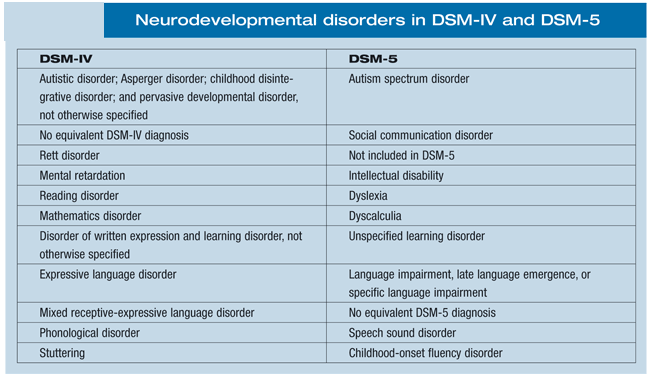 21 Transient tick
21 Transient tick - 307.20 No tick specified
sphincter control disorder
- Encoprese
- 787.6 Encoprese with constipation and urinary incontinence
- 307.7 Encoprese without constipation and urinary incontinence
- 307.6 Enuresis (not associated with a general disease)
Other disorders of infancy, infancy, or adolescence
- 309.21 Separation anxiety
- 313.23 Selective mutism
- 313.89Reactive attachment disorder in early or late childhood
- 307.3 Stereotypical movements
- 313.9 Diseases of infancy, late childhood or adolescence, unspecified
Summary
Delirium, dementia, amnestic disorder and other cognitive disorders
Delirium
- 293.0 Delirium due to general illness
- Delirium due to substance use
- Delirium due to substance poisoning
- Delirium due to substance withdrawal
- 780.
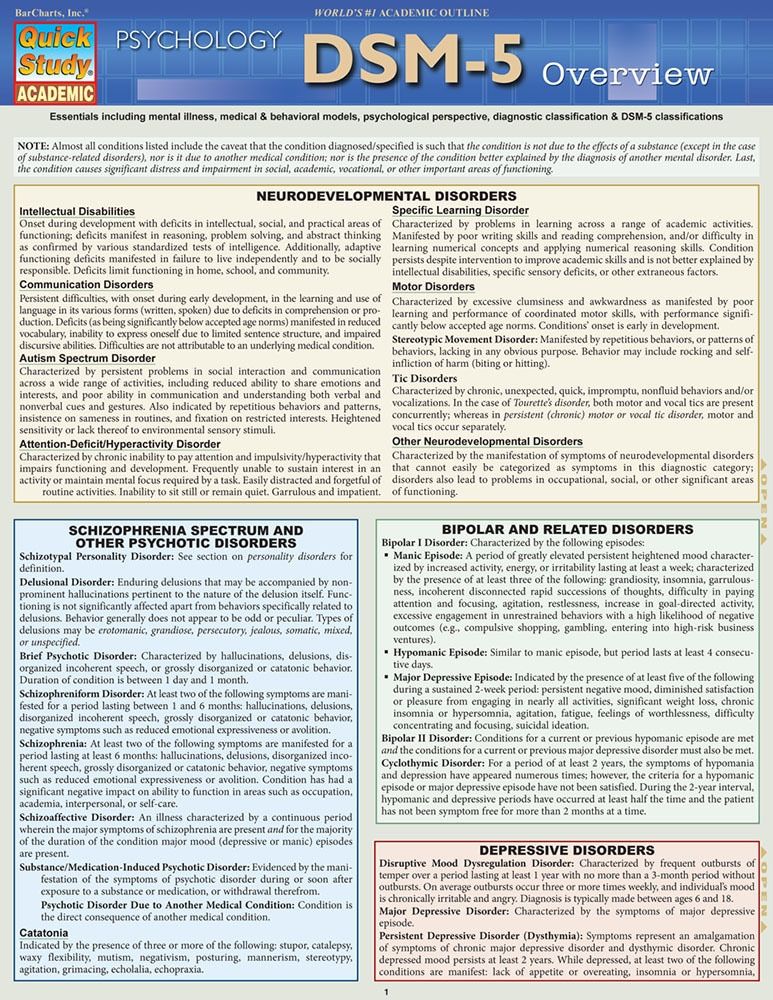 09 Delirium not specified
09 Delirium not specified
Dementia
- Dementia with early onset Alzheimer's disease
- 294.10 Without behavioral disorders
- 294.11 With behavioral disorder
- Alzheimer's dementia, late onset
- 294.10 No behavioral problems
- 294.11 With behavioral disorder
- Vascular dementia
- 290.40 -
- 290.41 With delirium
- 290.42 Delusional
- 290.43 When depressed
- Dementia due to AIDS
- 294.10 No behavioral problems
- 294.11 With behavioral disorder
- Dementia due to head injury
- 294.10 No behavioral problems
- 294.11 With behavioral disorder
- Dementia due to Parkinson's disease
- 294.10 No behavioral problems
- 294.11 With behavioral disorder
- Dementia due to Huntington's disease
- 294.
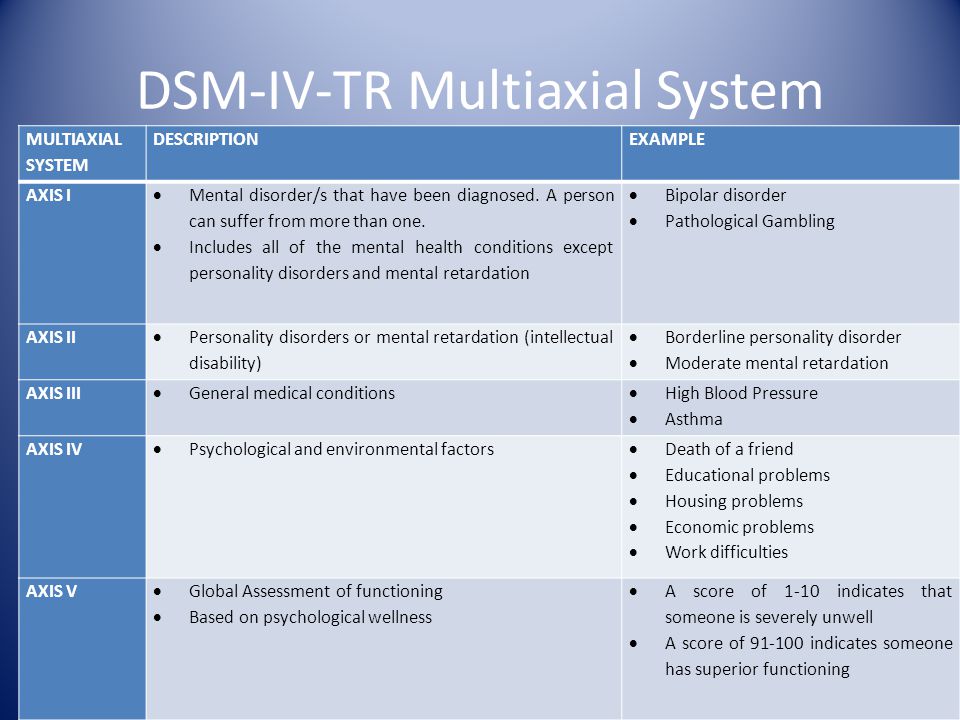 10 No behavioral problems
10 No behavioral problems - 294.11 With behavioral disorder
- 294.
- Pick's disease dementia
- 294.10 No behavioral problems
- 294.11 With behavioral disorder
- Creutzfeldt-Jakob disease dementia
- 294.10 No behavioral problems
- 294.11 With behavioral disorder
- Dementia due to another disease
- 294.10 No behavioral problems
- 294.11 With behavioral disorder
- 294.8 Dementia, unspecified
Amnestic disorder
- 294.0 Amnestic disorder due to general disease
- Persistent substance amnestic disorder
- 294.8 Amnestic disorder, unspecified
Other cognitive impairment
- 294.9 Unspecified cognitive impairment
Summary
Psychiatric disorders due to unspecified general health condition
- 293.89 Catatonic disorder due to .
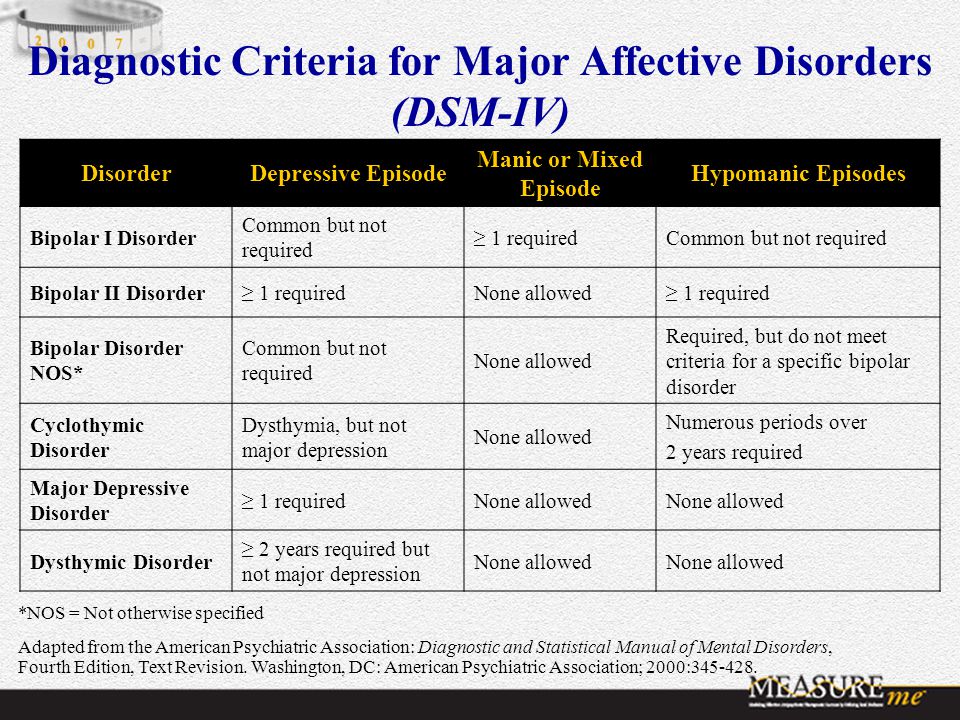 .. [specify general health condition]
.. [specify general health condition] - 310.1 Personality change due to ... [insert general health condition]
- 293.9 Unspecified mental disorder due to ... [specify general health condition]
Summary
Substance Use Disorders
Alcohol related disorders
- Alcohol
- 305.00 Abuse
- 303.90 Dependency
- 291.89 - Caused by anxiety disorder
- 291.89 - Caused by mood disorder
- 291.1 - Caused by persistent amnestic disorder
- 291.2 - Caused by persistent dementia
- 291.5 - Caused by delusional psychotic disorder
- 291.3 - Caused by psychotic disorder with hallucinations
- 291.89 - Caused by sexual dysfunction
- 291.89 - Caused by sleep disorder
- 303.00 Intoxication
- 291.0 Delirium due to poisoning
- 291.9 - Unspecified related disorder
- 291.81 Weaning
- 291.
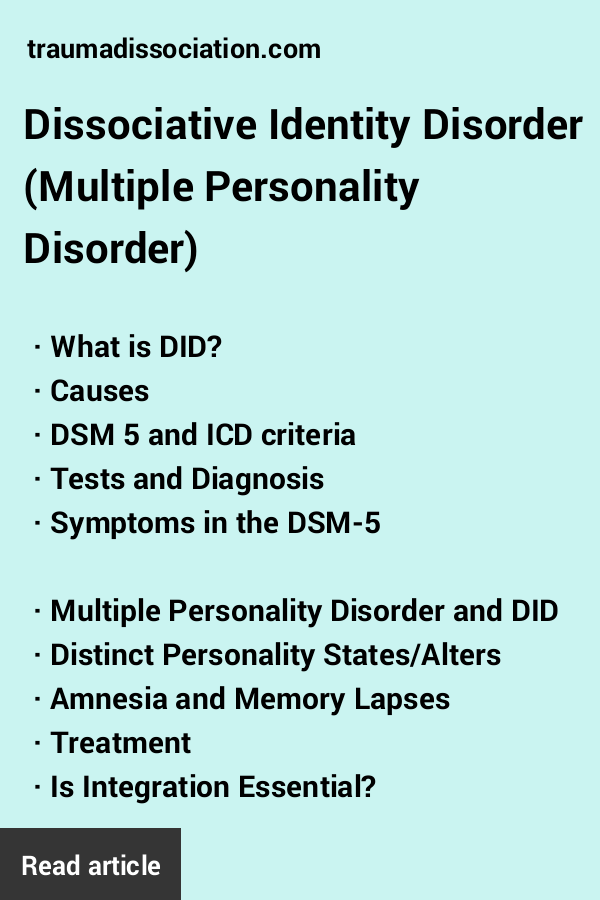 0 Weaning delirium
0 Weaning delirium
Amphetamine use disorders
- Amphetamine (or amphetamine type)
- 305.70 Abuse
- 304.40 Dependency
- 292.89 - Caused by anxiety disorder
- 292.84 - Caused by mood disorder
- 292.11 - Caused by delusional psychotic disorder
- 292.12 - Caused by psychotic disorder with hallucinations
- 292.89 - Caused by sexual dysfunction
- 292.89 - Caused by sleep disturbance
- 292.89 Intoxication
- 292.81 Delirium due to poisoning
- 292.9 - Other related disorder not specified
- 292.0 Weaning
Caffeine Related Disorders
- Caffeine
- 292.89 - Caused by anxiety disorder
- 292.89 - Caused by sleep disturbance
- 305.90 Intoxication
- 292.9 - Unspecified related disorder
Cannabis related disorders
- cannabis
- 305.
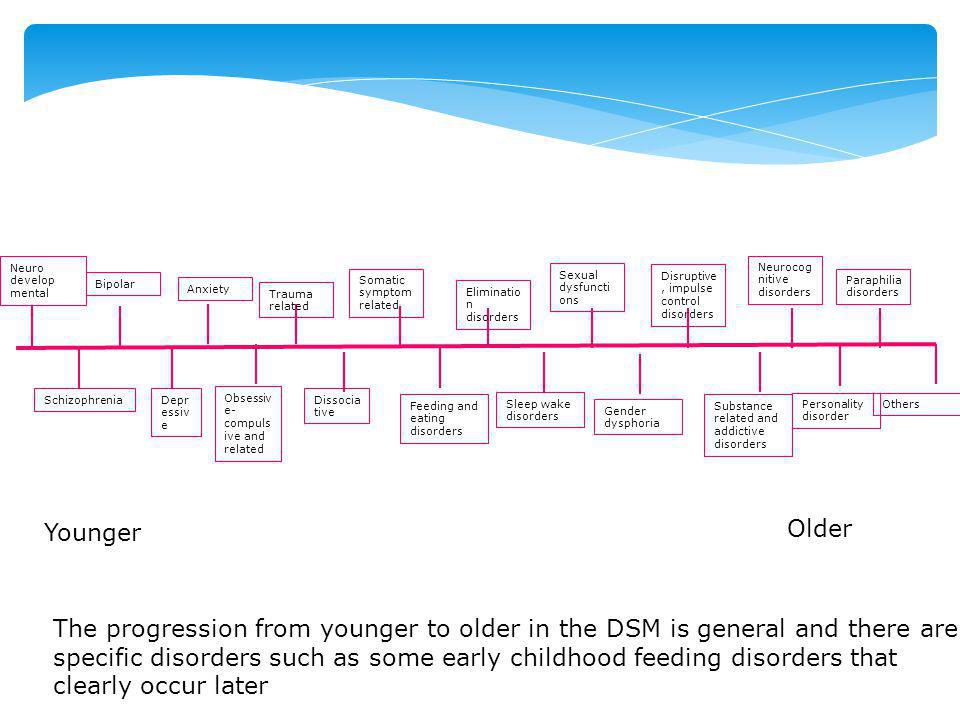 20 Abuse
20 Abuse - 304.30 Dependency (ru)
- 292.89 - Caused by anxiety disorder
- 292.11 - Caused by delusional psychotic disorder
- 292.12 - Caused by psychotic disorder with hallucinations
- 292.89 Intoxication
- 292.81 Delirium due to poisoning
- 292.9 - Unspecified related disorder
- 305.
Cocaine related disorders
- Cocaine
- 305.60 Abuse
- 304.20 Dependency
- 292.89 - Caused by anxiety disorder
- 292.84 - Caused by mood disorder
- 292.11 - Caused by delusional psychotic disorder
- 292.12 - Caused by psychotic disorder with hallucinations
- 292.89 - Caused by sexual dysfunction
- 292.89 - Caused by sleep disturbance
- 292.89 - Poisoning
- 292.81 Delirium due to poisoning
- 292.9 Unspecified related disorder
- 292.0 - Weaning
Disorders associated with hallucinogens
- Hallucinogens
- 305.
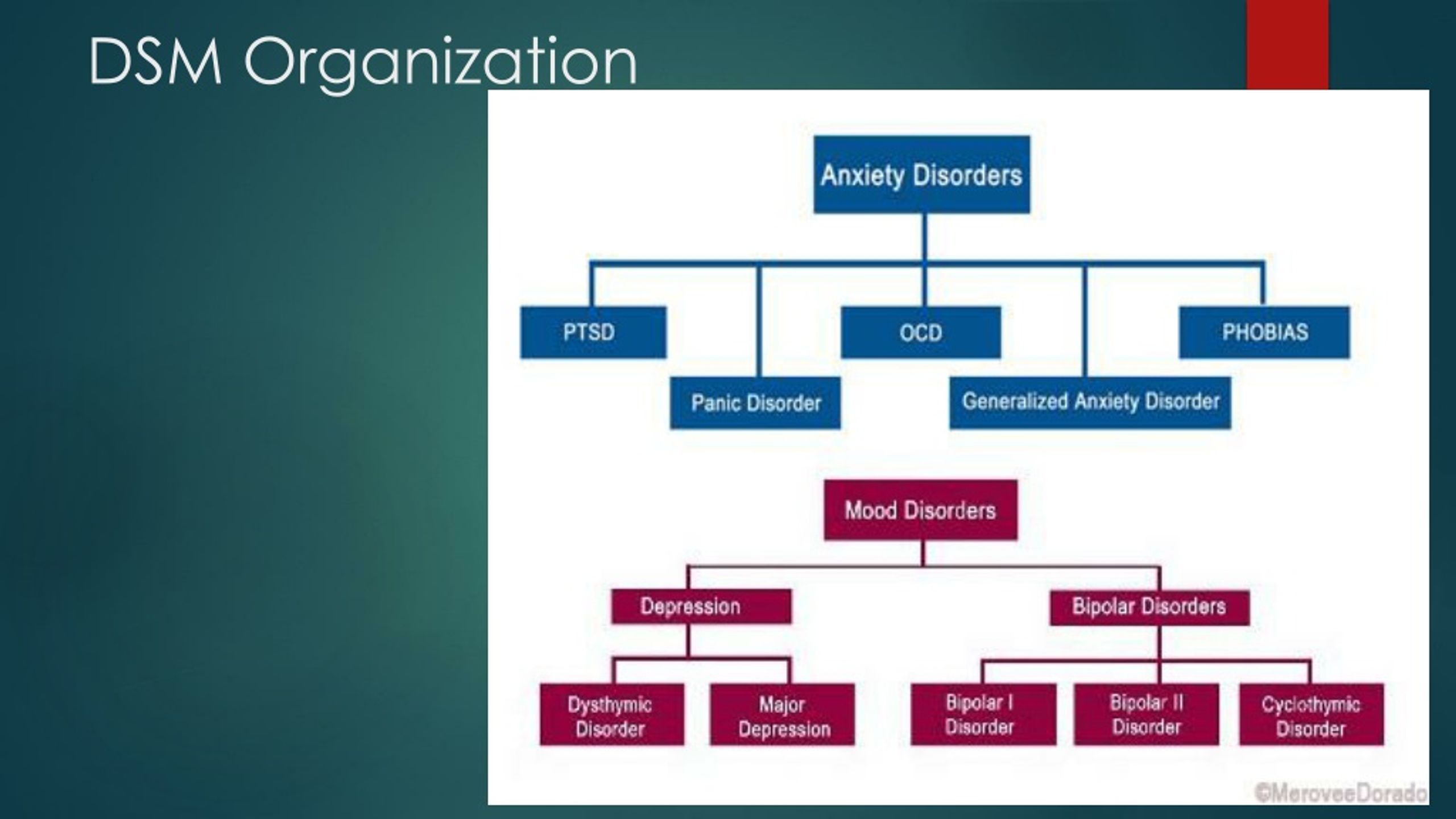 30 Abuse
30 Abuse - 304.50 Dependency
- 292.89 - Caused by anxiety disorder
- 292.84 - Caused by mood disorder
- 292.11 - Caused by delusional psychotic disorder
- 292.12 - Caused by psychotic disorder with delusions hallucinations
- 292.89 - Poisoning
- 292.81 - Delirium due to poisoning
- 292.89 Persistent perceptual disorder
- 292.9 Unspecified related disorder
- 305.
Violations involving volatile solvents
- Volatile solvents
- 305.90 Abuse
- 304.60 Dependency
- 292.89 - Caused by anxiety disorder
- 292.84 - Caused by mood disorder
- 292.82 - Caused by persistent dementia
- 292.11 - Caused by delusional psychotic disorder
- 292.12 - Caused by psychotic disorder with hallucinations
- 292.89 Intoxication
- 292.81 Delirium due to poisoning
- 292.9 - Unspecified related disorder
Disorders related to nicotine
- Nicotine
- 305.
 1 Dependency
1 Dependency - 292.9 - Unspecified related disorder
- 292.0 Weaning
- 305.
Opioid related disorders
- Opioid
- 305.50 Abuse
- 304.00 Outbuilding
- 292.84 - Caused by mood disorder
- 292.11 - Caused by delusional psychotic disorder
- 292.12 - Caused by psychotic disorder with hallucinations
- 292.89 - Caused by sexual dysfunction
- 292.89 - Caused by sleep disturbance
- 292.89 Intoxication
- 292.81 Delirium due to poisoning
- 292.9 - Unspecified related disorder
- 292.0 Weaning
Disorders associated with phencyclidine
- phencyclidine
- 305.90 Abuse
- 304.60 Dependency
- 292.89 - Caused by anxiety disorder
- 292.84 - Caused by sleep disturbance
- 292.11 - Caused by delusional psychotic disorder
- 292.12 - Caused by psychotic disorder with hallucinations
- 292.
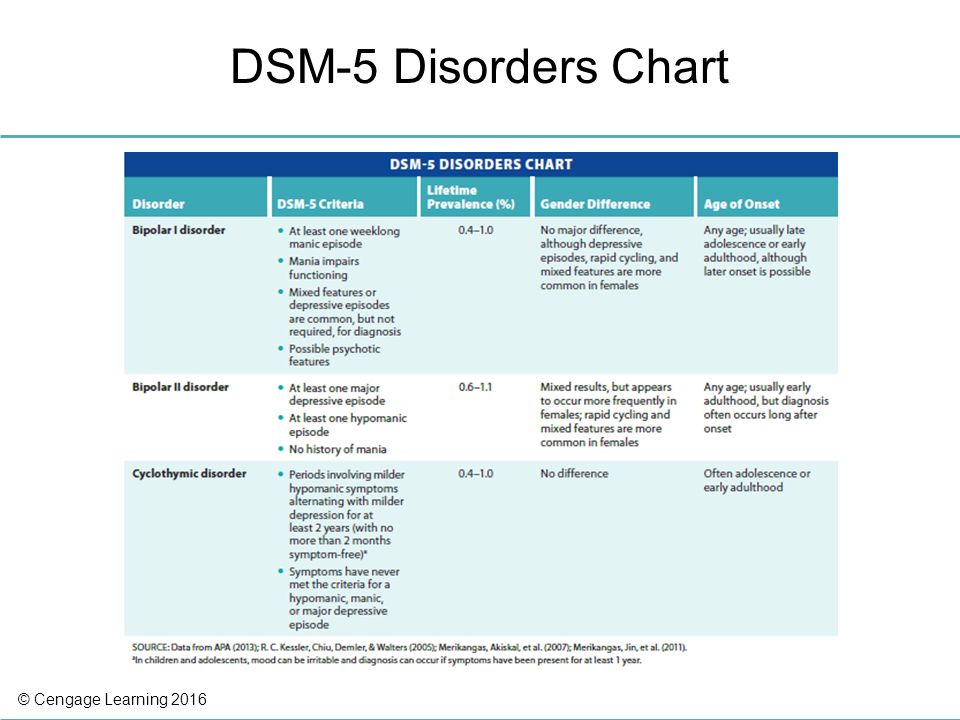 89 Intoxication
89 Intoxication - 292.81 Delirium poisoning
- 292.9 - Unspecified related disorder
Summary
Schizophrenia and other psychotic disorders
- Schizophrenia
- 295.20 Catatonic type
- 295.10 Hebephrenic type
- 295.30 Paranoid type
- 295.60 Residual
- 295.90 Undifferentiated type
- 295.40 Schizophreniform disorder
- 295.70 Schizoaffective disorder
- 297.1 Delusional disorder
- Erotomanic type
- Type of megalomania
- -
- -
- -
- Mixed type
- 298.8 Brief psychotic disorder
- 297.3 Madness of two men
- Psychotic disorder caused by ... [indicate general medical condition]
- 293.81 Delusional
- 293.82 With hallucinations
- 298.9 Unspecified psychotic disorder
Summary
Mood disorders
Depressive disorders
- 300.
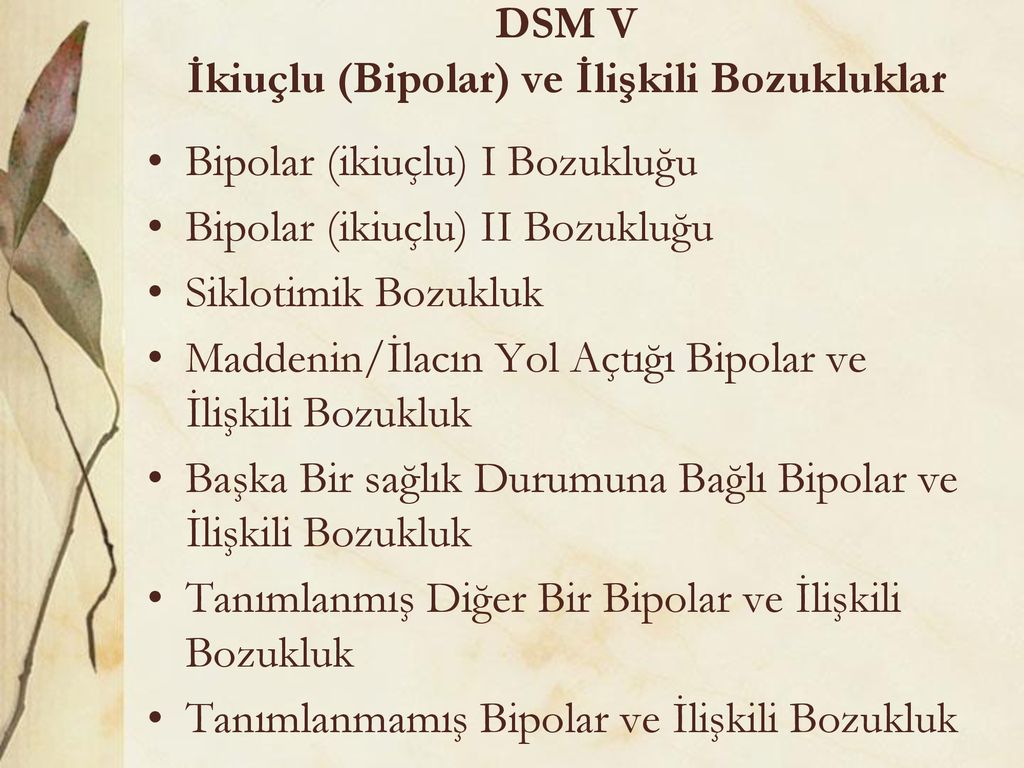 4 dysthymic disorders
4 dysthymic disorders - big depression
- Major depression, relapsing
- 296.36 -
- 296.35 -
- 296.31 Light
- 296.32 Moderate
- 296.33 Severe without psychotic symptoms
- 296.34 Severe with psychotic symptoms
- 296.30 Not specified
- -
- 296.26 -
- 296.25 -
- 296.21 Light
- 296.22 Moderate
- 296.23 Severe without psychotic symptoms
- 296.24 Severe with psychotic symptoms
- 296.20 Not specified
- Major depression, relapsing
- 311 Major depression, unspecified
Bipolar disorders
- Bipolar Disorders
- 296.80 Bipolar disorder not specified.
- Bipolar I disorder, recent depressive episode
- 296.56 -
- 296.55 -
- 296.51 Light
- 296.52 Moderate
- 296.53 Severe without psychotic symptoms
- 296.54 Severe with psychotic symptoms
- 296.
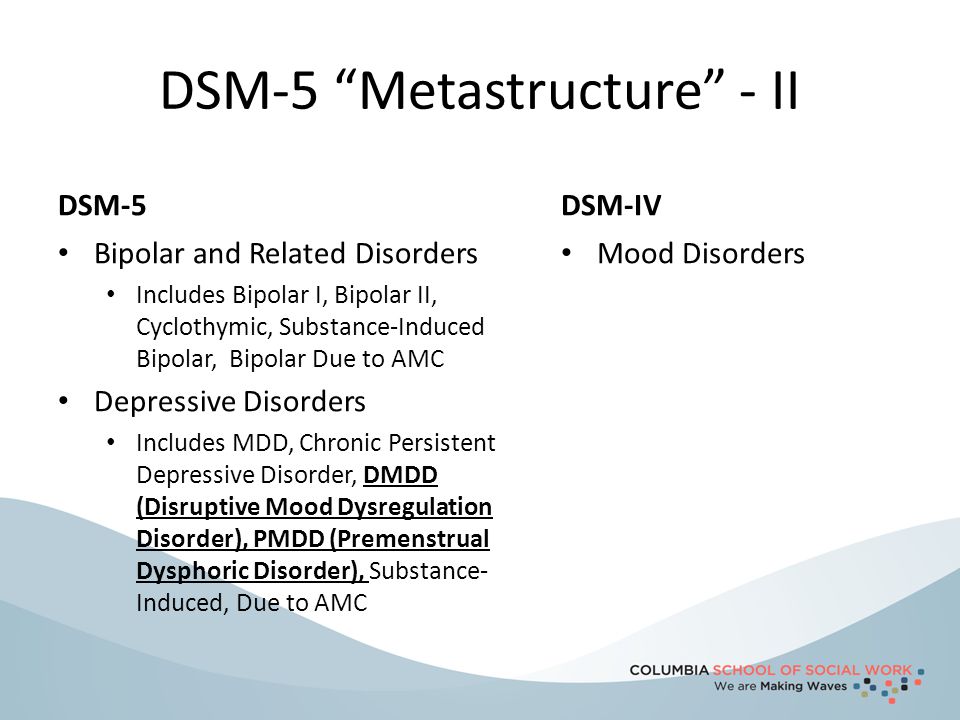 50 Not specified
50 Not specified
- 296.40 Bipolar I disorder, recent hypomanic episode
- Bipolar I disorder, manic episode
- 296.46 -
- 296.45 -
- 296.41 Light
- 296.42 Moderate
- 296.43 Severe without psychotic symptoms
- 296.44 Severe with psychotic symptoms
- 296.40 Not specified
- Bipolar I disorder, recent mixed episode
- 296.66 -
- 296.65 -
- 296.61 Light
- 296.62 Moderate
- 296.63 Severe, without psychotic symptoms
- 296.64 Severe with psychotic symptoms
- 296.60 Not specified
- 296.7 Bipolar disorder, recent episode unspecified
- -
- 296.06 -
- 296.05 -
- 296.01 Light
- 296.02 Moderate
- 296.03 Severe without psychotic symptoms
- 296.04 Severe with psychotic symptoms
- 296.00 Not specified
- 296.
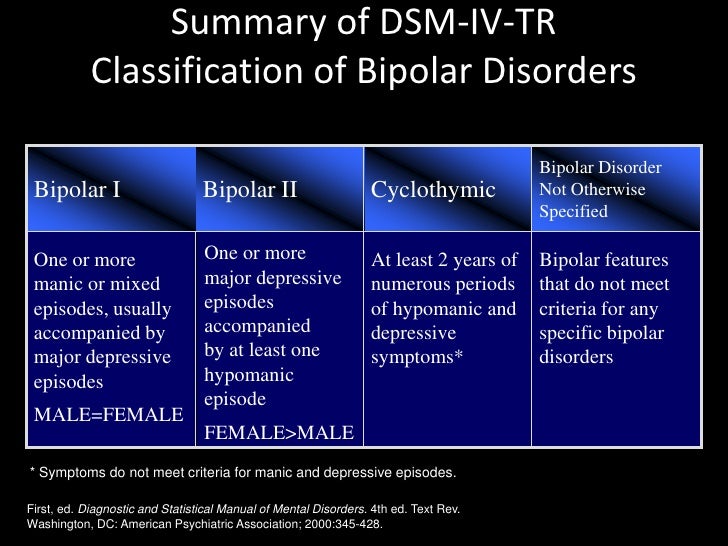 89 Bipolar II disorder
89 Bipolar II disorder
- 301.13 Cyclothymic disorder
- mood swings
- 293.83 Mood disorder due to ... [specify general health condition]
- 296.90 Mood disorder not specified.
Summary
Anxiety disorders
- 300.02 General anxiety
- fear of panic
- 300.21 For agoraphobia
- 300.01 Without agoraphobia
- 300.22 -
- 300.29 Specific phobia
- 300.23 Social phobia
- 300.3 Obsessive-compulsive disorder
- 309.81 Post-traumatic stress disorder
- 308.3 Acute stress reaction
- anxiety disorder
- 293.84 General anxiety disorder
- 293.89 Anxiety disorder caused by ... [specify general health condition]
- 300.00 Anxiety disorder not specified
Summary
Somatoform disorders
- 300.
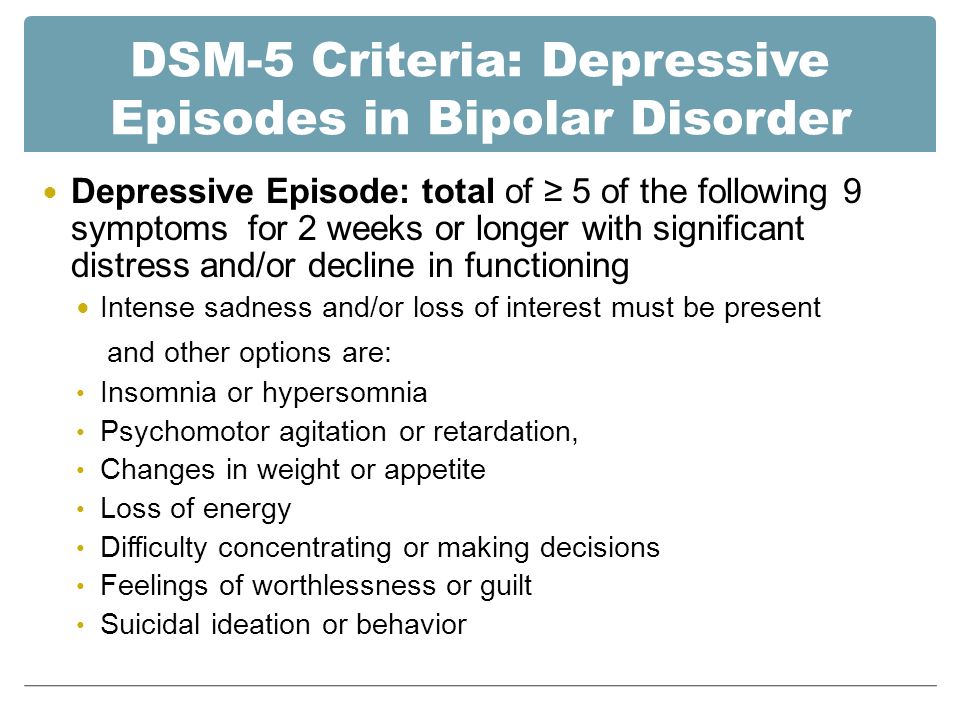 81 Somatizing disorder
81 Somatizing disorder - 300.82 Undifferentiated somatoform disorder
- 300.11 Conversion disorder
- -
- 307.89 -
- 307.80 Associated with psychological factors
- 300.7 Hypochondria
- 300.7 Dysmorphia
- 300.82 Somatoform disorder, unspecified.
Summary
Patomimy
- Pathomimia
- 300.19 -
- 300.19 -
- 300.16 -
- 300.19 Patomymia, unspecified
Dissociative disorders
- 300.6 Depersonalization
- 300.12 Dissociative amnesia
- 300.14 Dissociative identity disorder
- 300.15 Dissociative disorder, unspecified
Sexual Dysfunctions and Gender Identity Disorders
Sexual dysfunctions
- 625.8 - in women
- 608.89 - in humans
- 302.71 Decreased sex drive
- 302.79 Sexual disgust
- 302.
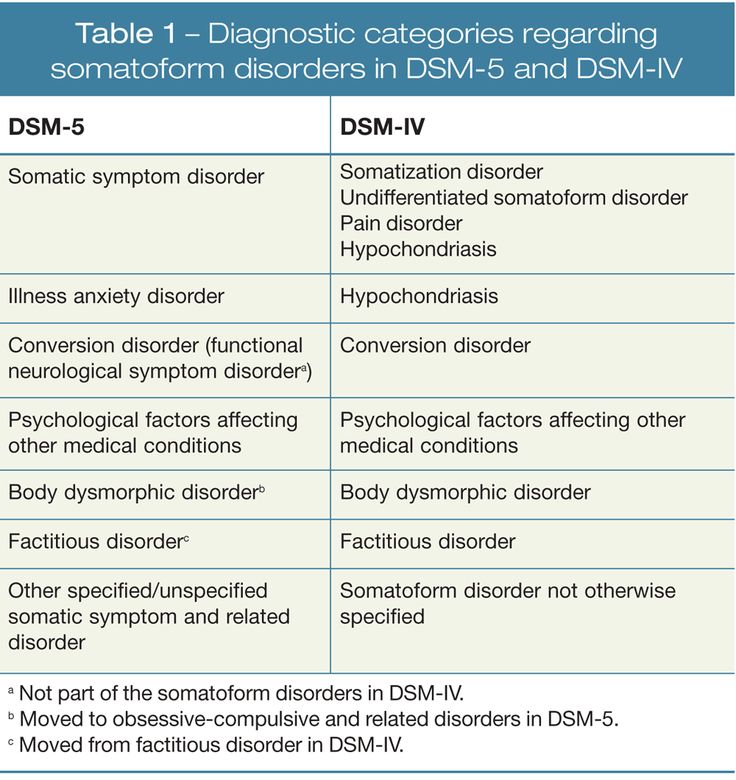 72 Erectile dysfunction in men
72 Erectile dysfunction in men - 302.72 -
- 607.84 -
- 302.73 Orgasm disorder in women
- 302.74 Male orgasm disorder
- 302.75 Premature ejaculation
- 302.76 Dyspareunia (not associated with a general disease)
- 625.0 -
- 608.89 -
- 306.51 vaginismus (not related to general health)
- 625.8 -
- 608.89 -
- harassment
- V61.1 -
- 995.81 -
- V61.21 -
- 995.5 -
- 302.70 Sexual dysfunction, unspecified
Deviations from sexual arousal
- 302.4 Exhibitionism
- 302.81 Fetish
- 302.89 Frottery
- 302.2 Pedophilia
- 302.83 Sexual masochism
- 302.84 Sexual sadism
- 302.3 Fetish transvestite
- 302.82 Voyeurism
- 302.9 Paraphilia, unspecified
Gender identity disorder
- Gender identity disorder
- 302.
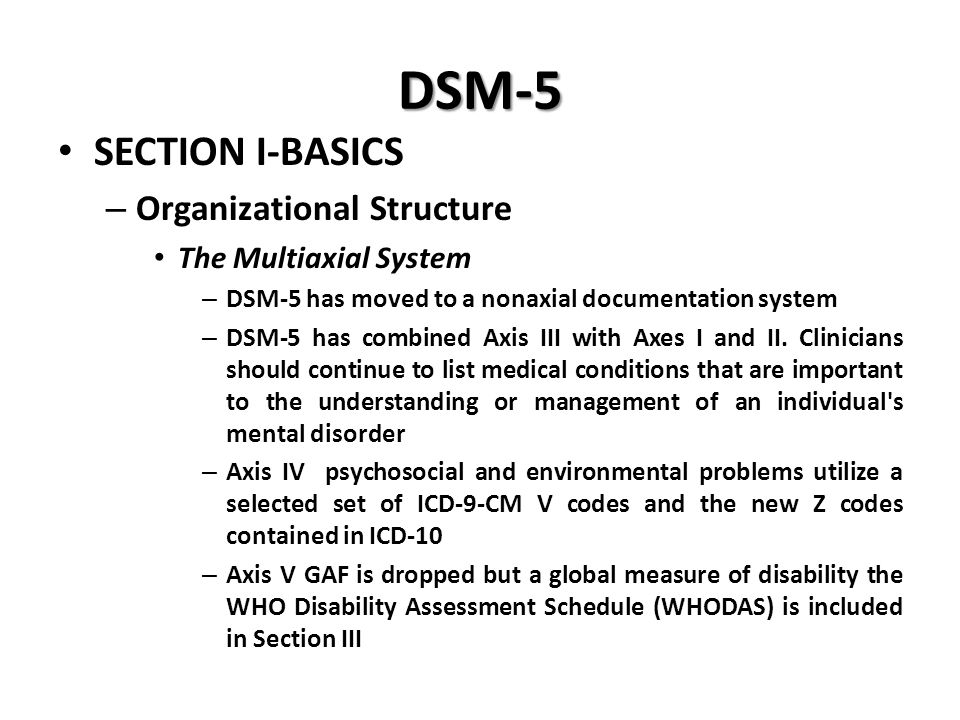 85 - adolescents or adults
85 - adolescents or adults - 302.6 - in children
- 302.6 Gender identity disorder unspecified
- 302.
- 302.9 Sexual disorder, unspecified
Eating disorders
- 307.1 Anorexia nervosa
- 307.51 Bulimia
- 307.50 Eating disorder, unspecified
Summary
Sleep problems
Primary sleep disorders
- 307.44 Primary hypersomnia
- 307.42 Primary insomnia
- 347 Narcolepsy
- 780.59 Respiratory sleep disorder
- 307.45 -
- 307.47 Dyssomnia, unspecified
Parasomnias
- 307.47 Nightmares
- 307.46 Night horror
- 307.46 Sleepwalking
- 307.47 Parasomnia, unspecified
Other sleep disorders
- sleep disorder
- Sleep disturbance due to ... [specify general health condition]
- 780.54 -
- 780.
 52
52 - 780.59 Mixed type
- 780.59 -
- 307.42 Rhythm disturbances
- 307.44 -
Violation of control over impulses is not indicated.
- 312.34 Intermittent explosive disorder
- 312.32 Kleptomania
- 312.31 Pathological gambling
- 312.33 Pyromania
- 312.39 Trichotillomania
- 312.30 Impulse control disorder not reported.
Adjustment Disorders
- Adjustment disorder
- 309.9 Not specified
- 309.24 With anxiety
- 309.0 For depression
- 309.3 -
- 309.28 For mixed anxiety and depression
- 309.4 -
Inappropriate character traits
Group A
- 301.0 Paranoid personality disorder
- 301.20 Schizoid personality disorder
- 301.22 Schizotypal personality disorder
Group B
- 301.
 7 Antisocial personality disorder
7 Antisocial personality disorder - 301.83 Borderline personality disorder
- 301.50 Histrionic personality disorder
- 301.81 Narcissistic personality disorder
Group C
- 301.82 Avoidant personality disorder
- 301.6 Dependent personality disorder
- 301.4 Obsessional neurosis
- 301.9 Personality disorder not otherwise specified
Summary
Related Articles
- Diagnostic and Statistical Manual of Mental Disorders
Notes and links
- ↑ US National Library of Medicine, Diagnostic and Statistical Manual of Mental Disorders. Reference , accessed 04/27/2021.
External links
- DSM-IV-TR
- (in) Diagnostic and Statistical Manual of Mental Disorders, 4- e revision edition published by the American Psychiatric Association (via archive.
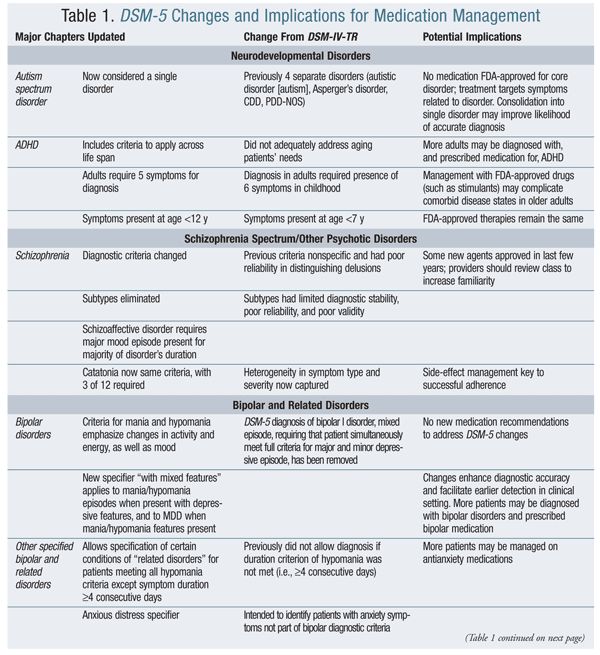
Learn more

